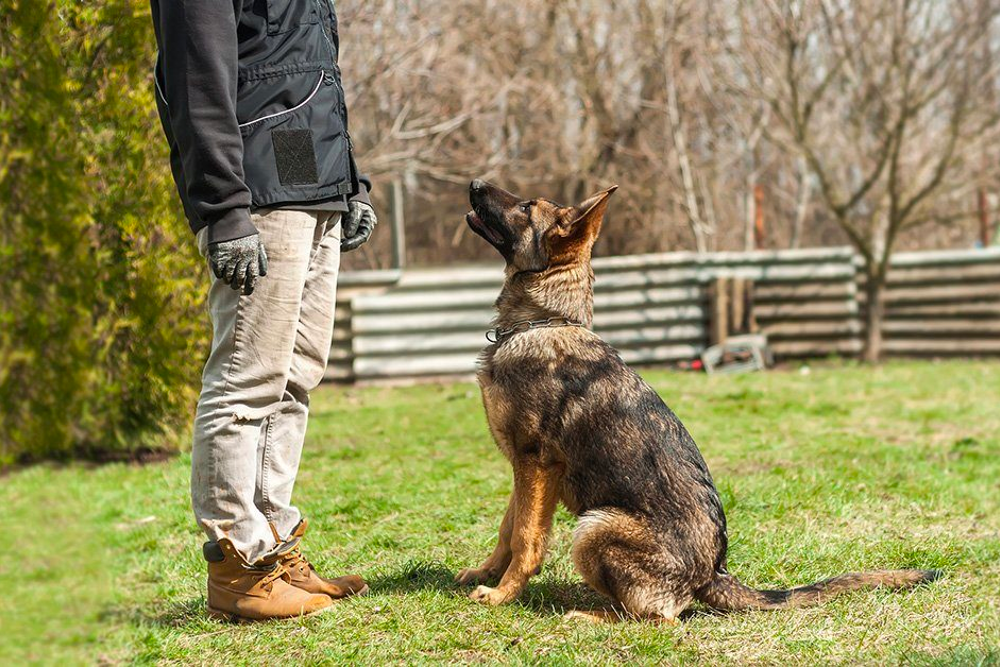Contents
Dog training has always been something quite mystic to many people. Especially for people who have never been with dogs, dog training seems to be a kind of magic, while it’s rather a science together that demands a lot of understanding of the species and their behaviors as a whole. This chapter is on German Shepherd training. Before we directly get into how to train German Shepherd Dogs, we give a brief overview of specific aspects of the breed that influence the training process. Once you understand the specific instincts, nature, and behavior of German Shepherds, you will understand what makes it easy to train your dog. So our first tip on German Shepherd training for you is going to be understanding the breed properly. If you are an avid enthusiast of German Shepherds, you will learn about German Shepherd training quickly.

There are, in fact, a number of techniques used in training German Shepherds, as for any other breed of dogs. Still, there are certain methods that are specifically used for the German Shepherd Dog breed, although most parts are obviously general. German Shepherd Dog is an intelligent breed and doesn’t require a too long time to make him learn new tricks. Still “Patience”, “Consistency” and “Repetition” are the most significant points to be kept in the forefront of the mind. The basic tricks that can be used for German Shepherd training are as follows:
1. Creating strong bondage-owner-dog relationship
As mentioned above German Shepherds are quite intelligent and they have a tendency to please their masters. It is hence suggested to build up a strong owner-dog relationship in the first place. Remember, Rusty is not going to listen to you if he doesn’t love you and trust you. Build up a strong bondage to with your German Shepherd Dog to make him trust your instincts. To be a good German Shepherd Dog trainer you need to spend a good amount of time making a bond with him… hug him, talk to him, whisper in his ears, exhale your breath softly and with love before his nose, and Rusty will surely understand your love-filled silent words.
2. No abuse
Inflicting pain – mentally and physically will make your job tougher. The most widespread watershed in the dog training discipline is whether you should include pain and fear to motivate your dog or not. In the past couple of decades, the inclination and awareness have been toward adopting dog training methods that involve no pain and fear. Force-free techniques of training German Shepherds and any other dog breeds have been the topic of discussion all over the world. Canine behaviorists and canine behavioral problem analysts are found in more abundance than in previous years. Inflicting pain and fear during German Shepherd training can turn out to be highly detrimental.
3. Play is of utmost importance
Make Rusty feel that training is a fun session and not a boring exercise class. Throw the ball; let him case it; pick it, bring it, while you call Rusty by his name. Reward him with treats once he gives the ball in your hand. Think of what can make the training session more fun for him. Training should be fun. A fearful puppy will be hard to train; hence you would want your subject to be playful and not fearful. Whether your German Shepherd is an adult or a puppy you cannot start out until his mind is out of fear.
4. Help him become confident at the outset
Help your shy GSD gain confidence… you cannot absolutely start off with a shy German Shepherd Dog. Build trustworthiness and help him become confident; it is only after that that you can start training your GSD. If your puppy is hiding behind you or the door, ears back, and exhibiting a worried expression on his face, he should be first put into a confidence-building session prior to putting him into general obedience training sessions.
5. Best time to start
Remember German Shepherd Dog is one of the most intelligent dog breeds in the world, and have always exhibited an inclination to please his pack leader. Use this instinct to teach new tricks to your German Shepherds. One who believes that “an old dog can’t learn new tricks” has never studied his dog. It is never too late for training German Shepherd Dogs. Your GSD has the ability to learn throughout his life, and this is an established fact!
Let us now move a step ahead and talk about advanced German Shepherd Training Tips
1. Establishing an Alpha membership
Remember, your GSD sees your family as a pack and every single member of your family is considered a pack member. Your position in the pack is most important. Until you make Rusty consider yourself as the pack leader (alpha), training will never be easy for you. A few tips here will help you get an idea of how to build and retain the alpha position in our pack.
- Make him follow; Don’t follow him – While walking your dog, let him follow you. This will make your dog see you as his leader. Be the first one to exit and enter your doorstep and let Rusty follow you, considering you as his alpha member (the pack leader). Allowing your dog to control you means he becomes the leader of the pack and training him is going to be the hardest nut to crack.
- Use a short leash – Using a short dog leash will help you get more control over him. You can effectively communicate with your German Shepherd Dog by fastening the leash to the top of the neck. This will also help you to correct your dog’s undesirable movement. Give slight jerks while correcting… but safety first!
- Do get distracted yourself – Do not get distracted yourself. Keep on leading him even when you are at home. Leading your German Shepherd doesn’t require you to be harsh on him. Love him as much as you want. Talk to him with love and make fun with him, but never let him go astray.
- Make him work for food – Give him small tidbits of his fave after he has worked as per desired. This will make him understand that he will be rewarded for all the good things he will do.
2. Maintain a fixed time
We suggest you train your German Shepherd Dog in the morning. In the morning, because dogs are diurnal, firstly. They have a fresh mind after a good sleep, secondly. And, morning hours, being usually calm, helps the dog to concentrate better than any other time during the day.
3. Consistency
Consistency in delivering command is of prime importance. If you are using the word “NO” for any undesirable behavior, you need to use the word “NO” for all undesirable behaviors throughout his life. Using different words may confuse your dog.
4. Repetition
As for any other training dog, German Shepherd training requires a considerable number of repetitions. Single action is to be repeated multiple times until he grabs the things properly. All repetition MUST be consistent and uniform. This is a method by which your GSD becomes proficient in any specific tricks. Repeat a single command about 10 times. Give a few minutes break and skip off to a new command and corresponding action; repeat this 10 times. Give a few minutes break again and come back to the previous command and corresponding action to be repeated 10 more times. Making sure the dog does not make the same mistake.
Trainer’s Tips To Train Your German Shepherds
If you are a GSD enthusiast, you know that GSD is a powerful dog and he (during his adulthood) would require a huge amount of exercise to maintain a balanced life. Playing fetch is probably the most effective exercise you can ever give to your German Shepherd in order to get his energy out. Playing is good, if and only if you frame a specific set of rules and limitations. It won’t be wise to let your German Shepherd Dog take advantage of playtime. Remember, it’s part of his training session, and he still needs to consider you as the Alpha Member (Pack leader).
1. Framing the Rules or His Play
It is important that you help your German Shepherd Dog know the specific type of play… not in his own whimsical way. You can frame behavioral policy or the game (fetching ball). For instance, make sure while playing he comes to you… stands still… not being restless… gives you eye contact… in the first place. Making a set of rules is of utmost significance and is one of the important prerequisites of training. His reward for this series of behavioral decencies should be the ball thrown for him to chess and fetch. Make sure you give breaks between throws.
2. Motivation exercise for your dog
This is important to become a successful dog trainer. Motivational exercise for your dog is motivating your GSD. For this, you need to create an environment that is friendly for him to perform. This also includes helping him get rid of all kinds of fears and shyness and helping your puppy gain confidence. As a trainer and handler, you need to know how to motivate so that you can easily take your training process one step ahead. It is all about creating a dog-friendly environment where your German Shepherd puppy would want to learn what you want to teach him. Motivation training steps include the following motivational factors:
a. Reward-based training
b. Using treats or toys as a reward
c. Praising your puppy lavishly for all desired actions, where praises are the motivation rewards
d. By using force (corrections) to make a dog
e. Non-abusive corrective measures
This page is just an overview of German Shepherd training. Dig deep into other GSD training chapters:

 Positive Motivation Dog Training Technique With Corrective Measures
Positive Motivation Dog Training Technique With Corrective Measures